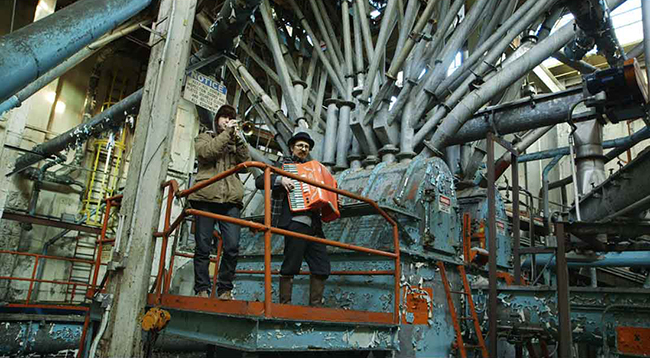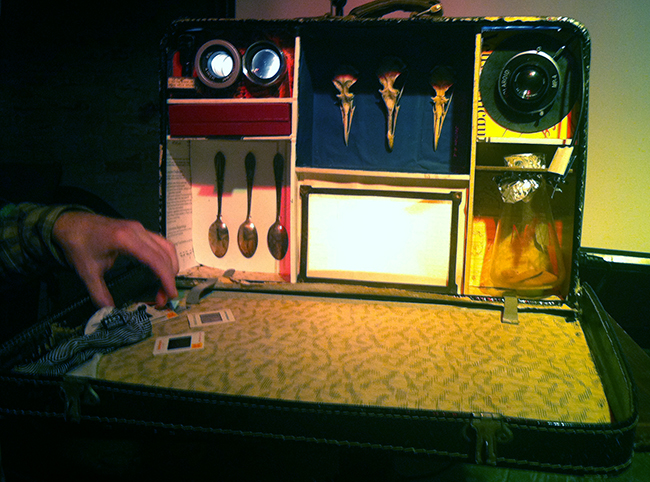
We are celebrating 15 years — and counting — of stories that are deeply researched and deeply felt, that build a historical record of what the city has been.
We are celebrating 15 years — and counting — of stories that are deeply researched and deeply felt, that build a historical record of what the city has been.
Upon entering the all-but-unmarked building on a barren street in post-industrial Gowanus, one of the prospective trespassers in attendance at Ida Benedetto and N.D. Austin’s “How to Trespass” lecture could have reasonably assumed that a primary component of the talk was the act of trespassing itself. But the Gemini & Scorpio Loft, the venue for the talk, was lawfully obtained, and its air of abandonment was diminished by an ornamental carousel horse, ample matching thrift store furniture, and a well-stocked bar. The event was hosted by Observatory, and the turnout of 250 exceeded the capacity of the loft, already much larger than the Observatory’s normal space. There is no doubt, however, that had Austin and Benedetto known people were being turned away at the door, they would have encouraged improvised entries to allow more to hear of their travails.
The kind of urban adventure that Austin and Benedetto were talking about goes far beyond a tourist’s quest to take full advantage of his New York CityPass. As the title suggests, an urban adventure of Austin and Benedetto’s persuasion must almost by definition include being in a space where one is not supposed to be. The pair has particular experience in this regard: beyond their personal hobby of exploration they also run Wanderlust, a project to bring others into inaccessible spaces to explore and engage with the locales’ curiosities and history.
Austin began by situating their urban explorations within the larger sphere of prankster culture and activist interventions (think Improv Everywhere and the Billboard Liberation Front). Though his account of the history of such exploration was sparse and best premised by his recurring caveat to questions of the law (“don’t take my word for it”), it did highlight the innate curiosity humans have for the closed off. Austin pointed to an account of Romans hiking along their formerly life-sustaining, then crumbling aqueducts and Dadaists’ exploration of abandoned churches in early-20th century France as historical precursors to Wanderlust’s forays into abandoned properties and forgotten spaces.
The event, subtitled “an illustrated lecture on the logistics and ethics of trespassing,” used these ventures as a point of departure into the “how to” of urban exploration. The centerpiece of the presentation was a romp through the wallowing Domino Sugar Refinery on the Williamsburg waterfront, a site stamped into the psyche of Brooklyn, signifying the loss of industry, gentrification, and community-dividing fights over affordable housing. Wanderlust recently succeeded in bringing 50 people into the factory of yore, under the nose of five security guards, for a morning of poking around.

The Wanderlust “Candyland Trespass Safari” took 50 people on an adventure through the abandoned Domino Sugar Refinery on the Williamsburg waterfront. Musical finale by Mat Dallow and Matt Giella. Photo courtesy of Wanderlust.
The crowd in attendance seemed most interested in learning the secrets behind the magicians’ tricks. Austin, like any good illusionist, did not part with this information freely, but instead focused on encouraging others to figure out the unique puzzles of their own trespass yearnings by providing additional knowledge of the trade. The “Dos” of urban exploration ranged from the very pragmatic (know the meaning of condemned building markings, understand hazardous materials signs, carry ID) to the comedic (take special care around properties with remnant McCain/Palin signs, wear unfashionable, sturdy Alaskan boots). The “Don’ts” were more numerous: don’t carry tools, don’t sneak and lurk, don’t dress up like a ninja, don’t worry too much about asbestos or lead paint, and, most importantly, don’t get shot.
The question of the ethics of trespassing was not, as you might expect, quite as clear-cut. Ostensibly, the audience had arrived to learn how to trespass, so, presumably, the majority was not categorically opposed to the act. Benedetto, rather than simply laying out the pair’s own code of ethical exploration, asked the audience for their thoughts. The conversation clearly dealt with a specific kind of trespassing: the exploration of abandoned spaces without damaging things, significantly altering the spaces, or intentionally causing anyone harm. I have no doubt that the group assembled would surely object to breaking down a door to a multifamily apartment building in order to steal a fashionable necklace.
Regardless of the ultimate product of trespassing – the trespasser’s wonder at a decrepit landmark or close observation of a spray-painted tag on a brick wall — the act of trespassing is clearly against the law. Austin had opened the evening with a definition of “ethical trespassing” offered by a commenter who clearly finds Wanderlust’s work problematic: “[this is] a form of illegal entry practiced by self-important, entitled yupsters whose sense of ethical superiority entitles them to decide which laws apply to them and which apply only to those who formerly occupied the places they have since gentrified and who now only constitute a nuisance in their great urban adventure.” The definition serves up a hefty dose of disdain for the supposed demographic that engages in this type of urban exploration. A cursory, judgmental take of the audience showed the community of prospective explorers to be largely white, heavily bearded, and trendily bespectacled – stereotypical hipsters interspersed with sprinklings of grunge and punk types that collectively fit the commenter’s bill. Beyond this contempt, the definition makes a defensible argument that “ethical trespassing” is no more than an oxymoron, a way to rationalize an illegal act. As many audience members pointed out, this argument rests on the assumption that an unlawful act is an inherently unethical act. Such conflation of illegal with unethical does not hold up when one looks at the history of codifying discrimination into law.
Granted, laws prohibiting trespassing and those banning, say, same-sex marriage are significantly different animals. Most attendees appeared familiar with the concept — wielded by sociologists and rights activists alike — that laws are social constructs that vary from culture to culture and are therefore not necessarily based in morality. One participant evoked the concept of Freedom to Roam, which expressly allows residents in many Nordic and United Kingdom nations varying degrees of access to private lands for recreation as long as no other crimes or destruction occur. While the concept, as codified in the traditions and laws of such countries, does not generally allow the exploration of the interiors of buildings, the contrast between this open approach to natural spaces and the U.S.’s more restricted approach to common use of privately held land is notable.

A wunderkammer, or cabinet of curiosities, collected during Austin’s excursions. | Photo by Jonathan Tarleton
Benedetto then posed the question of whether trespassing causes harm to others. Of course, this depends on the situation, as the audience response surely noted. A tromp around an abandoned warehouse that no one notices and leaves no trace is relatively harmless. Unfortunately, this is not always the outcome. If police are called on a figure climbing through a window, helicopters mobilized to pinpoint a bridge climber, or firefighters summoned to rescue a stranded explorer, the public is bearing financial costs as well as the opportunity cost of those resources not being available elsewhere. Austin and Benedetto stressed the principle of not bringing attention to their exploration, not only to avoid being arrested but also to limit these societal costs. Despite these intentions, bringing 50 people into one of the most controversial future development sites in the city does not quite square with this principle.
Wanderlust aspires to “transgressive placemaking.” Benedetto explained that the reintroduction of items and images of abandoned sites into the present day makes visible and creates places anew out of otherwise overlooked structures. In the case of Domino Sugar, the group sought to resituate the public eye on the complex at a crucial juncture in the plans for its future. Benedetto, like any archeologist, sees the seeds of renewed history and public understanding in a photograph of a confounding complex of pipes or a beaker of sugar scavenged from a dusty laboratory.
Such arguments for the benefits of trespassing do not make it an ethical practice. Indeed, adopting a philosopher-approved, normative ethical standard by which to judge trespassing was far outside the scope of the discussion. However, trespassing — and the images and artifacts it can release to an otherwise locked-out public — can produce awareness and foster newly imagined potential futures not possible otherwise. The creation story of the High Line starts with its haven as an urban explorer’s playground. Steve Duncan’s photographs of sewers and tunnels bring to light the otherwise dank, dark beauty of the city’s infrastructure. Perhaps New Yorkers partially owe the renovation of the High Bridge, a piece of abandoned infrastructure that has almost solely supported the paces of trespassers for the last 40 years, to urban explorers’ disregard for locked gates. As Austin and Benedetto made clear, the goal of Wanderlust and the impetus for their own exploration is curiosity. In an environment where much of what surrounds us goes unseen, looking up, around, over, and in can be an energizing catalyst for a better city.
Jonathan Tarleton is a writer, activist, and urbanist with aspirations to contribute to a more sustainable and inclusive urban environment. He is a project associate at Urban Omnibus and has made his way to Brooklyn from his roots in Georgia and North Carolina.
The views expressed here are those of the author only and do not reflect the position of Urban Omnibus editorial staff or the Architectural League of New York.
The views expressed here are those of the authors only and do not reflect the position of The Architectural League of New York.
Comments